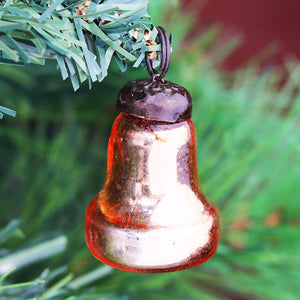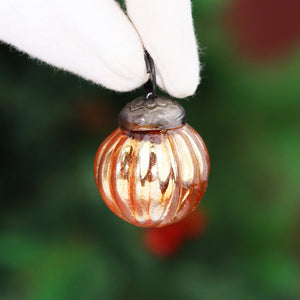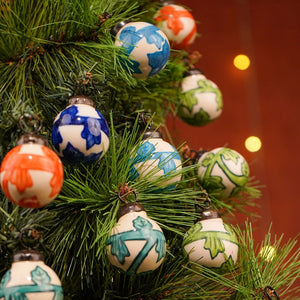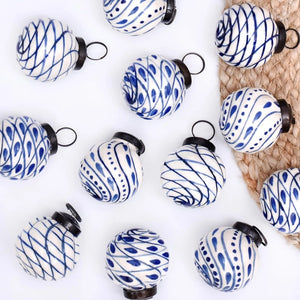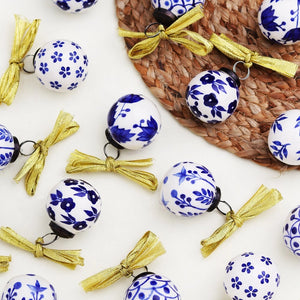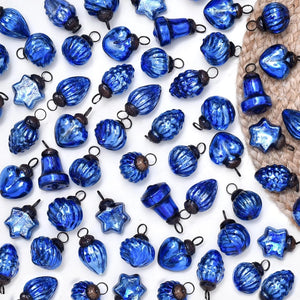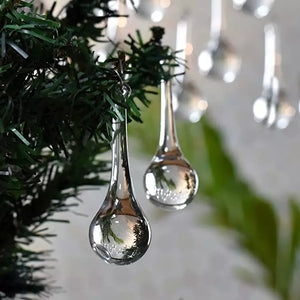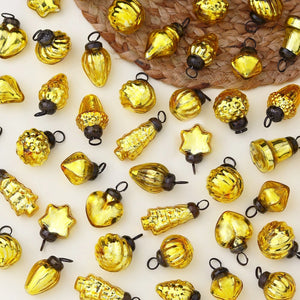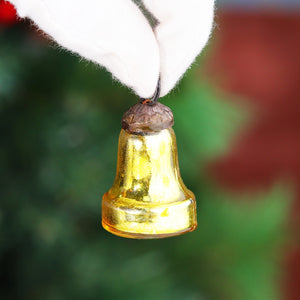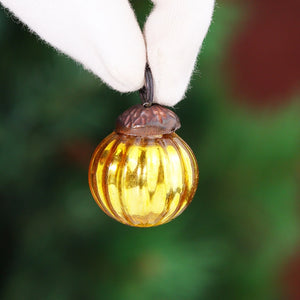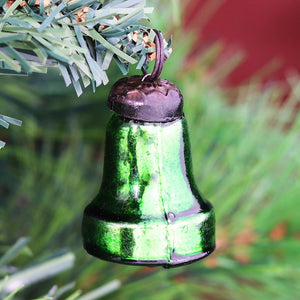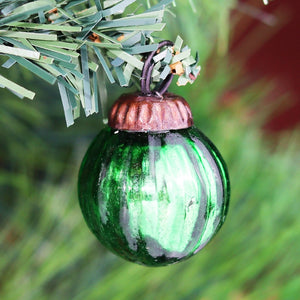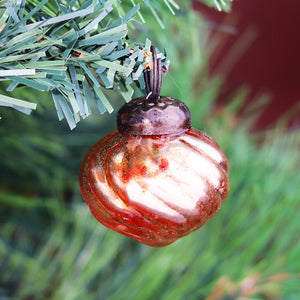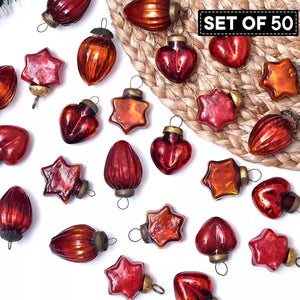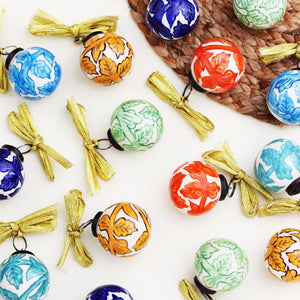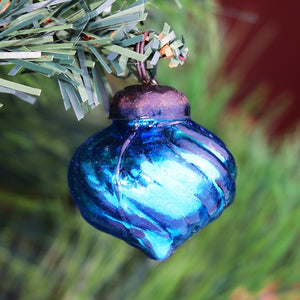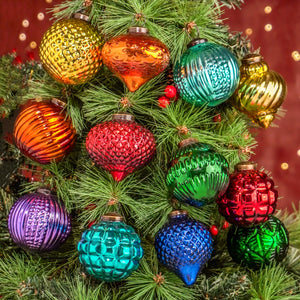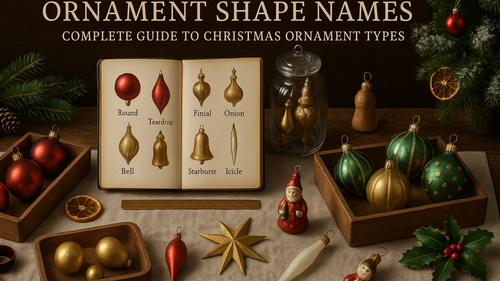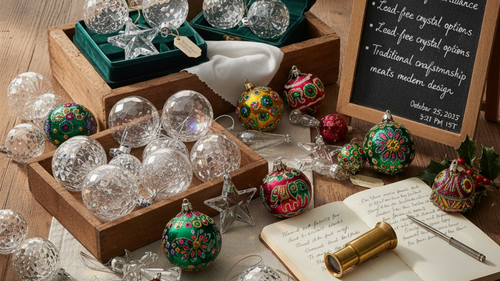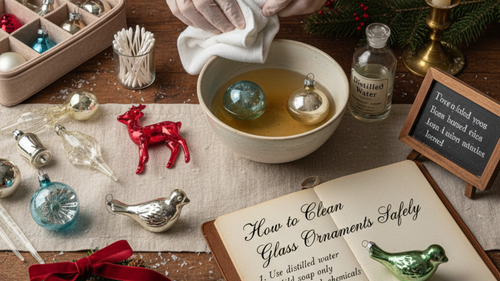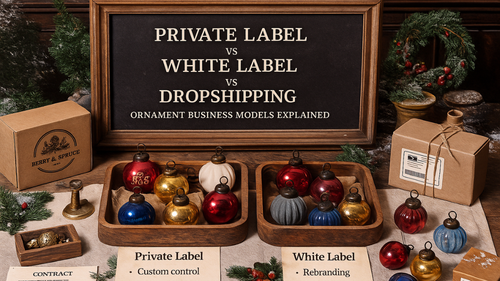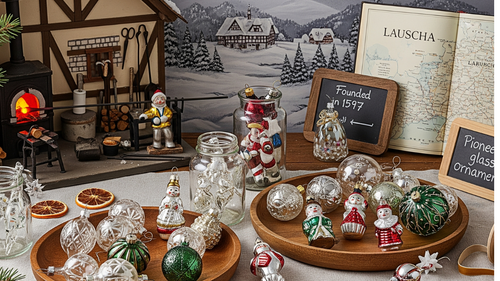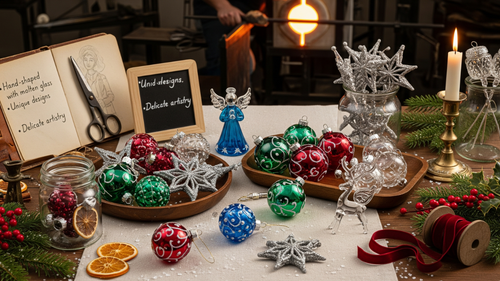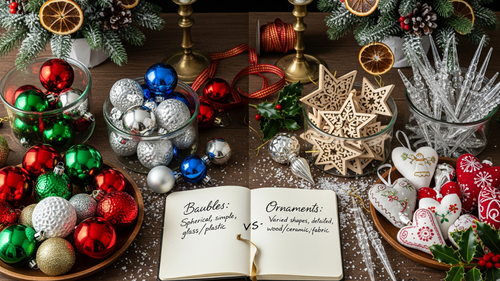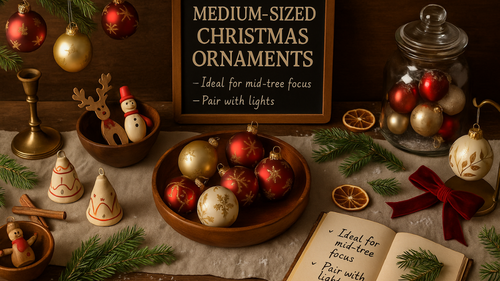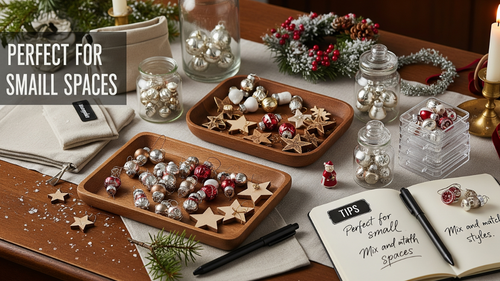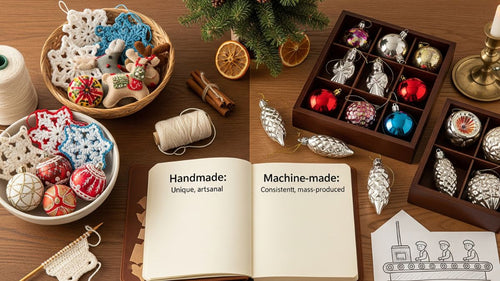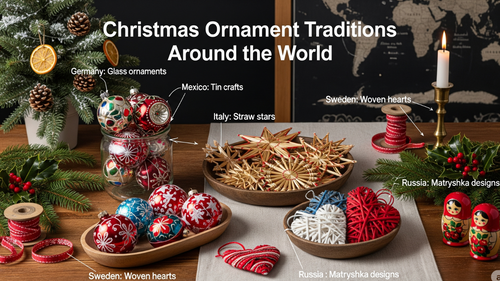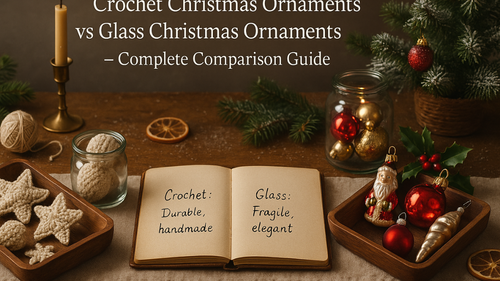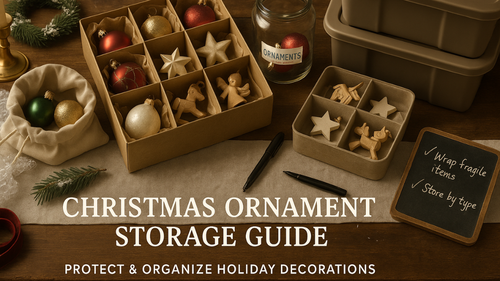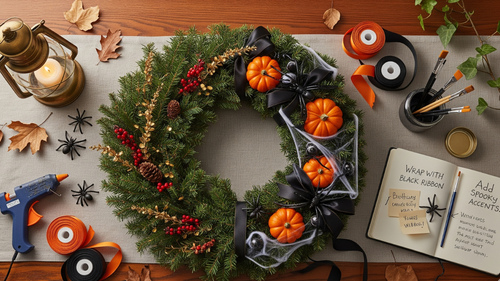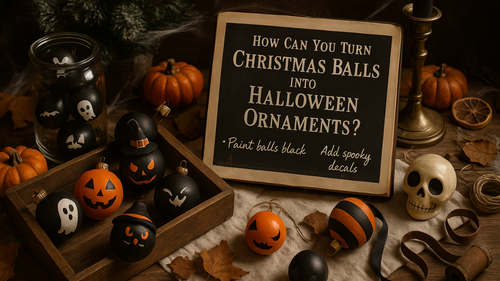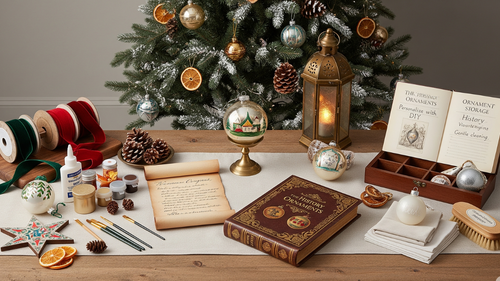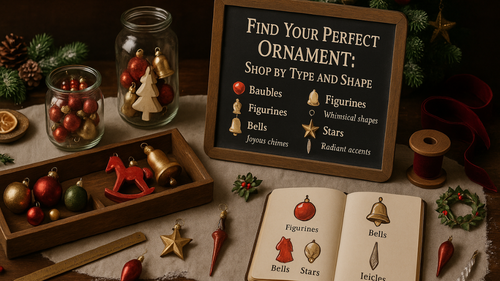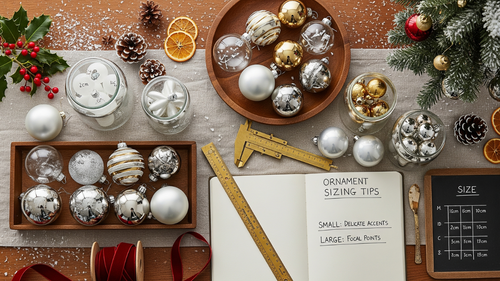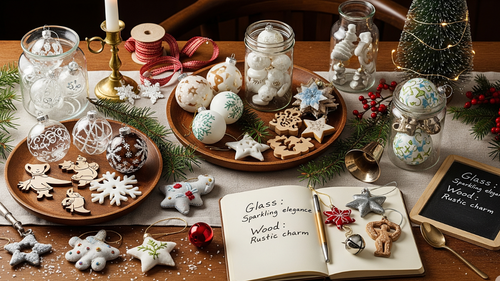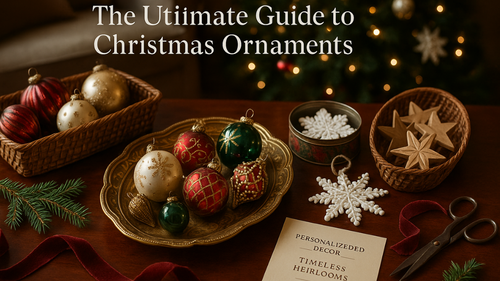Can You Use Christmas Ornaments in Halloween Decorations?
Yes—by changing colors, textures, and motifs, Christmas ornaments can serve as striking Halloween décor while saving money and reducing waste.
Halloween decorating doesn't require draining your budget or contributing to seasonal waste that fills landfills each November. Smart decorators across America are discovering that Christmas ornaments can be transformed into stunning Halloween décor through simple techniques like strategic repainting, texture additions, and creative repositioning.
The transformation concept works because both holidays share fundamental decorative elements: spherical shapes, dangling displays, twinkling lights, and garland applications. The primary difference lies in color schemes, materials, and thematic elements. Christmas ornaments provide the perfect structural foundation for Halloween displays while offering significant cost savings and environmental benefits.
Featured Products
This comprehensive guide explores proven methods to repurpose existing Christmas decorations for Halloween celebrations. From converting glass baubles into mysterious orbs to transforming garland into cobweb-draped strands, you'll discover cost-effective strategies that benefit both your decorating budget and environmental impact. Each technique includes safety considerations, material requirements, and step-by-step instructions for professional-quality results.
Whether you're a seasoned DIY enthusiast, budget-conscious decorator, or environmentally-minded homeowner, these techniques will help you create memorable Halloween displays using materials you already own. The methods scale from simple weekend projects to elaborate seasonal transformations, accommodating various skill levels and time commitments.
Why Repurposing Ornaments for Halloween Works
Color swaps, texture changes, and thematic embellishments convert Christmas pieces into spooky, stylish Halloween décor without purchasing new items.
Featured Products
The fundamental compatibility between Christmas and Halloween decorations stems from shared structural elements and display methods. Both holidays utilize hanging ornaments, twinkling lights, garland applications, and focal point trees. The transformation process capitalizes on these existing frameworks while introducing Halloween-specific colors and motifs.
Economic benefits prove substantial given current market conditions. The National Retail Federation projects 2024 Halloween spending will reach $11.6 billion, with $3.8 billion allocated specifically to decorations. Repurposing existing Christmas ornaments can reduce individual decoration costs by 60-80%, representing significant household savings.
Environmental advantages align with growing consumer consciousness about sustainability. From 2019 to 2024, total spending on Halloween decorations increased by 42% — from $2.6 billion to $3.8 billion, indicating massive consumption that can be reduced through repurposing practices. Each repurposed ornament prevents manufacturing demand for new items while extending existing product lifecycles.
Featured Products
Historical context supports this approach—ancient Samhain celebrations evolved into modern Halloween traditions, demonstrating how seasonal symbols naturally transform and adapt. Contemporary decorating follows similar patterns, with creative reinterpretation of existing elements rather than complete replacement.
2024 decorating trends emphasize nature-inspired designs, recycled materials, reclaimed elements, and conscious choices reflecting environmental awareness. Repurposing Christmas ornaments perfectly aligns with these contemporary preferences while delivering practical benefits.
How Can You Turn Christmas Balls into Halloween Ornaments?
Clean, prime, and repaint baubles in Halloween palettes; add decals, textures, or fillings for complete theme transformation. For more details, check out the blog on Turn Christmas Balls into Halloween Ornaments.
Featured Products

Christmas ball ornaments provide ideal foundations for Halloween transformations due to their versatile shapes and surfaces. Glass, plastic, and metal varieties each accept different treatment methods, allowing for comprehensive customization options. Learn more about the characteristics and benefits of different ornament materials to choose the best options for your Halloween transformation projects.
Surface Preparation Techniques
Proper preparation ensures paint adhesion and durability throughout the Halloween season. Begin with thorough cleaning using degreasing agents to remove manufacturing residues, fingerprints, and storage dust. Glass ornaments require acetone or rubbing alcohol application, while plastic versions need mild soap solutions. Understanding your ornament's base material is crucial for successful transformations. For detailed information on identifying and working with different ornament materials, see our comprehensive material guide.
Light surface abrading creates mechanical adhesion for paint. Use fine-grit sandpaper (220-320 grit) for gentle scuffing without damaging ornament integrity. Focus on glossy areas that naturally resist paint adhesion. Wipe clean with tack cloths to remove sanding particles.
Halloween Color Palette Applications
The most effective Halloween palette combines black, orange, purple, deep burgundy, and metallic copper. These colors create immediate seasonal recognition while offering sophisticated visual appeal beyond typical Halloween stereotypes.
Base coat application requires appropriate primers matched to ornament materials. Glass needs specialized glass primers, while plastic ornaments work with plastic-adhesion primers. Metal ornaments require rust-inhibiting metal primers for exterior durability.
Color application techniques vary by desired finish. Spray painting delivers smooth, even coverage ideal for solid colors. Brush application works better for distressed effects, color blending, and texture creation. Apply thin, multiple coats rather than single heavy applications to prevent runs and ensure durability.
Advanced Texture and Embellishment Methods
Texture additions transform simple color changes into sophisticated Halloween displays. Crackle mediums applied over base colors create aged, weathered appearances. Mica powders brushed over tacky varnish deliver metallic depth and shimmer effects.
Clear ornaments offer unique filling opportunities. Layer faux spider webs, miniature bats, preserved moss, tiny skulls, or orange/black sand for three-dimensional interest—secure fillings by replacing ornament caps with appropriate sealants.
Exterior embellishments include vinyl decals, lace wrapping, metallic chains, and dimensional elements. Hot-fix crystals, applied with appropriate tools, create sparkle effects. Ribbon treatments in Halloween colors add movement and textural contrast.
Specialized Finish Techniques
Matte versus glossy finishes have a dramatic impact on final appearances. Matte finishes create sophisticated, contemporary looks while glossy surfaces reflect light for dramatic effects. Satin finishes offer a compromise between the extremes.
Antiquing techniques using darker colors in ornament recesses create depth and visual interest. Dry brushing lighter colors over textured surfaces highlights raised areas. Color washing with translucent glazes creates complex, layered appearances.
How to Repurpose Old Christmas Garland for Halloween
Layer tinsel with gauze, faux webs, and themed trinkets to create atmospheric strands for mantels, banisters, and doorframes.

Christmas garland provides excellent structural foundations for Halloween transformations due to its existing fullness and established hanging mechanisms. The key involves layering Halloween elements while maintaining the original garland's fullness and flow.
Garland Base Assessment and Preparation
Evaluate the existing garland condition before beginning transformations. Check for damaged sections, loose connections, and worn areas requiring repair. Clean thoroughly to remove dust and storage odors that might interfere with adhesives or paint applications.
Different garland types require specific approaches. Needle garland accepts spray painting for color changes, while tinsel varieties work better with weaving techniques. Fabric garlands can be over-dyed for color transformation.
Halloween Element Integration Methods
Successful garland transformation requires strategic element placement rather than random addition. Create focal points at regular intervals—approximately every 18-24 inches—using larger Halloween items like plastic spiders, miniature skulls, or bat cutouts.
Weave faux spider webbing throughout the garland length, securing with small amounts of clear adhesive or tiny wire ties. The webbing should appear naturally occurring rather than deliberately placed.
Add skeleton hands, miniature pumpkins, and black ravens at irregular intervals to create discovered-treasure effects. Secure with floral wire wrapped in garland colors to maintain invisible attachment points.
Lighting Integration for Atmospheric Effects
Orange and purple micro-LED strings create dramatic Halloween atmospheres when woven through transformed garland. Position lights to backlight translucent elements and create silhouette effects with opaque decorations.
Battery-powered LED options eliminate extension cord requirements and provide greater placement flexibility. Solar-powered versions work for outdoor installations but require adequate charging exposure.
Outdoor Installation Considerations
Exterior garland installations require weather-resistant materials and secure fastening systems. Use stainless steel or galvanized hardware to prevent rust staining on house surfaces.
Protect electrical connections with weatherproof covers rated for outdoor use. Ensure all electrical components meet outdoor safety standards and connect through GFCI-protected outlets.
Wind resistance becomes crucial for outdoor installations—secure garland at multiple points rather than relying on end-point attachment alone. Use guy-wires or additional anchor points for long spans exposed to wind.
How to Create a Spooky Halloween Tree Using Christmas Ornaments
Use black or white base trees, then layer recolored baubles, themed toppers, and coordinated ribbon to build cohesive spooky focal points.

Halloween trees represent one of the most dramatic transformation projects, converting familiar Christmas displays into stunning Halloween centerpieces. The approach builds on established tree decorating skills while introducing Halloween-specific elements and color schemes.
Tree Base Selection and Preparation
Black artificial trees create the most dramatic Halloween foundations, though white trees offer sophisticated alternatives for elegant Halloween displays. Existing green trees can be spray-painted using specialized flocking techniques, though this represents a permanent modification.
Tree size considerations depend on available space and desired impact. Tabletop trees (2-4 feet) work well for centerpiece applications, while full-size trees (6-8 feet) create room-dominating displays. Consider weight limitations for ornament loads—Halloween modifications often add significant weight.
Ornament Placement Strategies
Follow traditional tree decorating principles while incorporating Halloween modifications. Our designer's guide to ornament sizing provides essential foundation knowledge for creating visually balanced Halloween trees. Place the largest ornaments deeper into the tree branches for stability and visual depth. Cluster similar colors in triangular patterns for balanced visual weight distribution.
Mix repurposed Christmas baubles with Halloween-specific additions like miniature pumpkins, plastic ravens, and hanging spider decorations. Maintain approximately 60% repurposed ornaments to 40% Halloween-specific items for a cost-effective balance.
Layered Lighting for Haunting Effects
Orange and purple LED strings provide foundation lighting, while accent lights create specific effects. Use warm white lights sparingly for contrast and depth. Avoid cool white lights, which conflict with Halloween color palettes.
Flickering LED options simulate candlelight effects appropriate for Halloween themes. Position flicker lights near translucent ornaments for enhanced effect. Battery-powered LED candles scattered throughout branches add additional atmospheric lighting without fire hazards.
Topper and Finishing Touches
Halloween tree toppers replace traditional stars or angels with ravens, witches' hats, or elaborate bow arrangements in Halloween colors. Ensure toppers are proportionally appropriate and securely fastened.
Ribbon treatments in black, orange, or purple create flow and movement. Use wired ribbon for shape retention and easy adjustment—drape ribbon in loose swags rather than tight wrapping for natural movement.
Tree skirt alternatives include black fabric, artificial spider webs, or Halloween-themed materials. Consider elevated placement on decorative stands rather than traditional floor positioning for enhanced visual impact.
How to Use Christmas Lights for a Haunted Halloween Look
Re-deploy string lights in orange/purple configurations to silhouette props, highlight pathways, and create atmospheric backlighting effects.

Christmas lights adapt perfectly to Halloween applications through strategic color selection, placement modifications, and integration with Halloween-specific elements. The transformation leverages existing electrical infrastructure while creating entirely different atmospheric effects.
Color Selection and Psychological Impact
Orange lights create warm, welcoming Halloween atmospheres while maintaining safety for trick-or-treaters. Purple lights generate mysterious, supernatural effects ideal for adult Halloween parties. Combination installations balance approachability with dramatic impact.
Green lights simulate eerie, otherworldly effects but should be used sparingly as accent elements rather than primary lighting. Red lights create dramatic silhouettes but can appear emergency-related, potentially confusing neighbors or authorities.
Strategic Placement Techniques
Uplighting creates dramatic silhouettes when lights shine upward through fog or onto walls. Position lights at ground level, pointing toward architectural features, trees, or large Halloween props for maximum shadow effects.
Pathway lighting guides trick-or-treaters safely while contributing to the Halloween atmosphere. Use orange lights in existing landscape lighting fixtures or add temporary installations for seasonal enhancement.
Window backlighting transforms ordinary windows into spooky focal points. Position lights behind translucent Halloween decorations or colored filters for dramatic interior-to-exterior effects.
Integration with Fog and Atmospheric Effects
Low-lying fog machines combined with ground-level lighting create otherworldly effects. Position lights to shine upward through fog for maximum visual impact. Ensure fog machine placement allows for safe trick-or-treater navigation.
Strobe effects using programmable LED controllers create lightning simulation or supernatural appearances. Use strobing sparingly to avoid seizure triggers and neighbor complaints. Consider timer controls for limited-duration effects.
Power Management and Safety Considerations
Halloween lighting often requires more power than Christmas installations due to additional effects and longer daily operation periods. Calculate total wattage requirements and ensure adequate circuit capacity.
Outdoor installations require weatherproof connections and appropriate extension cords rated for exterior use. Use GFCI-protected outlets for all outdoor electrical connections. Inspect all connections before each use.
Timer controls reduce energy consumption and provide consistent operation schedules. Programmable timers allow for complex lighting sequences coordinated with peak trick-or-treat hours.
How to Make a Halloween Wreath with Old Christmas Ornaments
Start with grapevine or mesh bases; cluster dark baubles strategically, add texture with ribbon and natural elements, and finish with dramatic centerpieces.

Wreath transformation represents one of the most rewarding repurposing projects, converting familiar Christmas displays into striking Halloween focal points. The process builds on established wreath-making techniques while incorporating Halloween-specific materials and design principles.
Base Selection and Preparation
Grapevine wreaths provide natural, rustic foundations ideal for Halloween themes. The irregular texture and organic coloring complement Halloween aesthetics better than perfectly uniform bases.
Mesh wreaths offer contemporary alternatives with excellent ornament attachment capabilities. Black mesh creates dramatic backgrounds for colorful ornaments, while orange mesh provides warm, welcoming foundations.
Existing Christmas wreaths can be modified rather than completely reconstructed. Remove Christmas-specific elements while retaining useful structural components and established attachment points.
Ornament Clustering and Visual Balance
Successful Halloween wreaths follow the triangle principle for visual balance. Position large ornament clusters at 10, 2, and 6 o'clock positions to create stable visual foundations.
Group ornaments in odd numbers (3, 5, 7) for natural, pleasing arrangements. Vary sizes within clusters to create depth and visual interest. Secure with floral wire rather than hot glue for weather resistance and repositioning capability.
Color distribution requires strategic planning. Distribute darkest colors (black, deep purple) evenly around the wreath circumference. Use brightest colors (orange, metallic copper) as accent points rather than dominant elements.
Texture and Natural Element Integration
Halloween wreaths benefit from texture variety beyond smooth ornament surfaces. Incorporate preserved autumn leaves, dried seed pods, miniature pinecones, and bare twigs for natural complexity.
Faux spider webbing applied judiciously creates a Halloween atmosphere without appearing artificial. Stretch webbing slightly for a natural appearance and secure with small amounts of clear adhesive.
Feathers, particularly black raven feathers or orange/brown pheasant feathers, add movement and organic texture. Secure feather bases deeply into the wreath structure for wind resistance.
Centerpiece and Focal Point Development
Dramatic centerpieces elevate Halloween wreaths beyond simple decoration to artistic statements. Options include realistic ravens, miniature skulls, elaborate bow arrangements, or seasonal harvest elements.
Proportion remains crucial—centerpieces should complement rather than overwhelm the overall composition. Generally, centerpieces should occupy no more than 15-20% of total wreath area.
Secure centerpieces with multiple attachment points to withstand weather and handling. Consider removable attachment methods for centerpieces that might be used elsewhere.
How to Create a Haunted Christmas Village
Transform existing villages by repainting structures in grayscale palettes, adding miniature Halloween elements, and using atmospheric lighting techniques.

Christmas villages provide excellent foundations for Halloween displays due to established architectural elements, existing lighting systems, and familiar scale relationships. The transformation process maintains structural integrity while introducing Halloween-specific modifications.
Architectural Modifications and Color Schemes
Village structure modifications focus on color rather than architectural changes. Grayscale palettes create immediately recognizable haunted appearances while preserving original detail work.
Use a primer specifically formulated for the village material—typically ceramic or resin. Apply base coats in medium gray, then dry-brush lighter grays and whites to highlight architectural details. Add darker grays and blacks to recessed areas for depth and shadow effects.
Whether aging techniques enhance haunted appearances. Diluted brown washes applied to roof areas simulate aging and neglect. Light sanding of raised areas creates realistic wear patterns.
Scale-Appropriate Halloween Elements
Halloween additions must maintain proper scale relationships with existing village structures. Miniature tombstones, tiny jack-o'-lanterns, and appropriately-sized Halloween figures preserve the illusion of a complete miniature world.
Create cemetery areas using miniature headstones arranged in realistic patterns. Add bare trees using model railroad techniques and materials. Position miniature Halloween figures as village inhabitants rather than obvious decorations.
Street-level details include miniature Halloween decorations on building facades, tiny carved pumpkins, and scale-appropriate seasonal elements. These details reward close examination while contributing to overall atmosphere.
Atmospheric Lighting and Special Effects
Lighting modifications dramatically enhance haunted village atmospheres. Replace existing warm white LEDs with purple or orange alternatives. Use flickering LEDs in building windows to simulate candlelight or firelight.
Under-glow lighting positioned beneath the village base creates mysterious atmospheric effects. Purple LED strips create supernatural ambiance, while orange lighting suggests campfires or jack-o'-lantern glows.
Fog effects are achieved using aquarium air pumps and hidden tubing, creating low-lying mist effects suitable for village-scale settings. Position fog outlets strategically to simulate natural mist patterns around buildings and water features.
How to Make a Halloween Centerpiece from Christmas Decorations
Fill decorative vessels with repurposed ornaments, seasonal elements, and coordinated lighting for sophisticated table focal points.

Halloween centerpieces using Christmas decorations create elegant seasonal displays suitable for both casual family gatherings and formal entertaining. The approach emphasizes sophistication over stereotypical Halloween imagery.
Container Selection and Preparation
Container choice dramatically impacts the final centerpiece's appearance and style. Elegant glass bowls create upscale presentations, while rustic wooden boxes suggest casual, farmhouse aesthetics.
Cauldrons and lanterns provide obvious Halloween connections while maintaining decorative sophistication. Metallic finishes in copper, bronze, or pewter complement Halloween color palettes while avoiding overly cartoonish appearances.
Size considerations must account for dining practicality. Centerpieces should remain below eye level when seated—typically under 12-14 inches tall. Width should allow for comfortable conversation across table surfaces.
Layered Composition Techniques
Successful centerpieces utilize layering principles similar to floral arrangements. Begin with foundational elements, add medium-height components, then finish with accent pieces and lighting.
Foundation layers might include preserved moss, colored sand, or decorative stones in Halloween colors. These materials provide visual weight and secure upper-layer elements.
Medium-height elements include repurposed ornaments in Halloween colors, miniature pumpkins, pine cones, and seasonal foliage. Vary heights within this layer for visual interest and natural appearance.
Color Story Development
Sophisticated Halloween centerpieces utilize refined color palettes rather than bright, primary Halloween colors. Deep burgundy, copper, bronze, and cream create elegant autumn sophistication.
Metallic accents in copper and bronze add richness without overwhelming other elements. Use metallic elements sparingly as highlights rather than dominant features.
Texture variety within chosen color palettes creates visual interest. Combine smooth ornament surfaces with rough natural materials, glossy finishes with matte elements, and hard materials with soft textiles.
Integrated Lighting Solutions
Battery-powered LED strings eliminate cord management issues while providing atmospheric lighting. Warm white LEDs complement autumn color palettes better than cool white alternatives.
LED candles provide candlelight ambiance without fire hazards or wax dripping concerns. Position LED candles at varying heights throughout the centerpiece for natural, flickering effects.
Uplighting using small LED spotlights positioned within the centerpiece creates dramatic shadow effects and highlights textural elements. Use timer controls for consistent lighting schedules.
How to Repurpose Christmas Stockings for Halloween
Transform stockings through dyeing, painting, and appliqué techniques to create Halloween treat containers and decorative elements.
Christmas stockings adapt readily to Halloween applications through color modification and thematic embellishments. The familiar shape and hanging mechanism translate directly to Halloween candy collection and decorative display functions.
Fabric Dyeing and Color Transformation
Fabric dyeing provides comprehensive color changes for light-colored stockings. Commercial fabric dyes in black, orange, and purple create dramatic transformations suitable for Halloween themes.
Follow the dye manufacturer's instructions precisely for color fastness and durability—pre-wash stockings to remove sizing and surface treatments that might interfere with dye uptake.
Over-dyeing techniques allow for color blending and custom effects. Red stockings over-dyed with black create deep burgundy effects, while white stockings accept any color transformation.
Paint Applications and Surface Treatments
Fabric paints offer greater control than dyeing for specific design elements and limited color areas. Stenciling techniques create professional-looking Halloween motifs, including bats, spiders, skulls, and seasonal text.
Heat-setting requirements vary by paint type—follow manufacturer instructions for permanence and wash resistance. Generally, heat-setting involves iron application on the reverse sides after complete drying.
Dimensional fabric paints create raised effects and textural interest. Use sparingly for accent details rather than large area coverage to maintain fabric flexibility.
Appliqué and Embellishment Techniques
Fabric appliqués provide quick, professional-looking Halloween transformations. Pre-made appliqués attach with heat-activated adhesives or traditional sewing techniques.
Custom appliqués cut from Halloween-themed fabrics allow for unique designs. Use fusible web products for easy attachment and finished edges that resist fraying.
Trim additions, including lace, chains, ribbons, and decorative cords, enhance Halloween themes while adding textural interest. Secure with fabric glues or traditional sewing methods.
Functional Adaptations
Halloween stockings serve multiple functions beyond traditional decoration. Use as candy collection bags for trick-or-treating, party favor containers, or seasonal gift presentations.
Reinforcement modifications might be necessary for heavy candy loads. Add interfacing or lining materials to prevent stretching and tearing during use.
Hanging modifications accommodate different display locations and weight requirements. Strengthen hanging loops and consider alternative hanging methods for heavier applications.
How to Use Christmas Ornaments in a Halloween Costume
Transform baubles into wearable accessories like headpieces, jewelry, belt elements, and props while prioritizing lightweight, shatterproof materials for safety.
Christmas ornaments offer unique opportunities for costume enhancement, creating eye-catching accessories that stand out from typical Halloween costume elements. The key lies in selecting appropriate ornament types and secure attachment methods that withstand movement and interaction.
Material Selection for Wearable Applications
Shatterproof plastic ornaments provide optimal safety for costume applications compared to glass alternatives. Weight considerations become crucial for comfort during extended wear periods—plastic ornaments typically weigh 60-80% less than equivalent glass versions.
Foam ornaments offer the lightest weight options but may lack durability for costume applications involving significant movement or interaction. Consider intended use duration when selecting materials.
Metallic plastic ornaments create dramatic visual effects while maintaining lightweight characteristics essential for comfortable wear. These work particularly well for witch costumes, steampunk themes, and fantasy characters.
Headpiece and Hair Accessory Construction
Ornament headpieces require secure foundations to prevent shifting during movement. Headband bases provide stable platforms for ornament attachment while distributing weight across the head circumference.
Attachment methods include hot glue for permanent installation or wire wrapping for removable options. Wire techniques allow for ornament reuse in other applications after costume season.
Balance considerations prevent headpieces from tilting or causing discomfort. Distribute ornament weight evenly and consider counterbalancing techniques for asymmetrical designs.
Jewelry and Body Accessory Applications
Ornament necklaces create dramatic costume focal points. Use jewelry chain or cord appropriate to costume themes—metallic chains for gothic looks, leather cord for rustic themes, ribbon for elegant presentations.
Earring applications require lightweight ornaments to prevent ear discomfort. Miniature ornaments work best for earring conversions. Ensure earring findings are appropriate for ornament weight.
Belt elements and waist accessories incorporate ornaments into costume silhouettes. Attach to existing belts or create custom waist pieces using appropriate foundation materials.
Prop Integration and Accessories
Ornaments enhance costume props like staffs, wands, and ceremonial items. Secure attachment prevents ornament loss during costume activities and photo sessions.
Cape and cloak decorations using ornaments create movement and visual interest. Position ornaments to catch light during movement for maximum visual impact.
Shoe and footwear decorations require secure attachment methods that withstand walking and dancing. Consider removable attachment options to preserve footwear for future use.
How to Decorate a Halloween Table Using Christmas Ornaments
Incorporate baubles as napkin rings, scatter décor, cloche displays, and place card holders while coordinating with elegant Halloween table settings.
Halloween table decorating using Christmas ornaments creates sophisticated seasonal presentations suitable for dinner parties, family gatherings, and special occasions. The approach emphasizes elegance over typical Halloween clichés while maintaining clear seasonal identity.
Place Setting Integration
Ornament napkin rings provide simple yet elegant Halloween table accents. Use medium-sized ornaments (2-3 inches) in Halloween colors, securing with decorative cord or ribbon that coordinates with the overall color scheme.
Place card applications utilize miniature ornaments as unique table markers. Attach small tags with guest names using thin ribbon or wire. This creates memorable take-home favors while serving practical table organization functions.
Individual place setting accents include small ornaments positioned at each setting as decorative elements. Coordinate colors with dinnerware and linens for cohesive presentations.
Centerpiece and Focal Point Development
Halloween table centerpieces benefit from height variation and layered compositions. Use ornaments of varying sizes arranged in groupings that create visual triangles and balanced compositions.
Glass cloche displays showcase special ornaments while creating elegant focal points. Position LED tea lights beneath cloches for dramatic uplighting effects that highlight ornament details and create atmospheric ambiance.
Runner and pathway decorations incorporate ornaments into table surface designs. Scatter smaller ornaments along table runners or create defined pathways using coordinated ornament groupings.
Color Coordination and Sophisticated Palettes
Elegant Halloween table settings avoid bright, primary Halloween colors in favor of sophisticated autumn palettes. Deep burgundy, copper, bronze, and cream create refined seasonal presentations suitable for formal entertaining.
Metallic accents using copper and bronze ornaments complement candlelight and enhance overall table ambiance. Use metallic elements sparingly as highlights rather than dominant features.
Monochromatic schemes using varying shades of single colors create contemporary, upscale presentations. All-black schemes with metallic accents appear particularly sophisticated for adult Halloween entertaining.
Lighting Integration and Ambiance
Candle and ornament combinations create romantic, atmospheric lighting appropriate for Halloween entertaining. Position candles safely away from flammable decorations while maintaining a visual relationship with ornament groupings.
LED alternatives provide safety advantages while maintaining atmospheric effects. Battery-powered LED candles eliminate fire hazards while creating flickering candlelight appearances.
Uplighting techniques using small LED spotlights positioned beneath ornament groupings create dramatic shadow effects and enhance ornament surface textures and colors.
How to Reuse Halloween Ornaments for Christmas
Transform Halloween decorations back to Christmas themes through strategic repainting, removal of embellishments, and seasonal motif additions.
The reversibility of ornament transformations maximizes decorating investments while supporting year-round creative projects. Understanding reverse transformation techniques ensures ornaments can serve multiple seasonal functions throughout their lifecycles.
Paint Stripping and Surface Restoration
Successful reverse transformations often require complete paint removal to restore original surfaces or prepare for new color applications. Paint stripping techniques vary by ornament material and existing paint type.
Chemical strippers work effectively on glass and metal ornaments but may damage plastic materials. Test strippers on inconspicuous areas before proceeding with complete removal.
Mechanical removal using fine abrasives provides controlled paint removal suitable for all ornament materials. Use progressively finer grits to achieve smooth, paint-ready surfaces.
Christmas Color Palette Applications
Traditional Christmas colors, including red, green, gold, and silver, create immediate seasonal recognition. These colors work particularly well over darker Halloween base colors that provide depth and richness.
Metallic finishes in gold and silver create elegant Christmas presentations suitable for sophisticated holiday decorating. Apply metallic paints over appropriate base colors for depth and luminosity.
Contemporary Christmas palettes, including white, silver, and blue, offer modern alternatives to traditional colors while maintaining a clear seasonal identity.
Christmas Motif Integration
Christmas-specific decorative elements transform Halloween ornaments into recognizable holiday decorations. Snowflake stencils, star patterns, and evergreen motifs provide clear Christmas identification.
Glitter applications in Christmas colors create sparkle effects appropriate to holiday celebrations. Apply glitter over tacky varnish bases for secure adhesion and minimal shedding.
Ribbon treatments in Christmas colors and patterns enhance ornament presentations while providing hanging enhancements and color coordination opportunities.
Color Psychology in Halloween Decoration Transformations
Understanding color psychology principles enhances transformation effectiveness by creating desired emotional responses and atmospheric effects.
Color selection dramatically impacts the success of Christmas-to-Halloween ornament transformations. Understanding psychological responses to different colors enables more effective decorative choices that create intended atmospheres and emotional responses.
Primary Halloween Color Psychology
Orange stimulates warmth, enthusiasm, and welcoming feelings while maintaining clear Halloween identification. This makes orange ideal for family-friendly Halloween displays that need to appear inviting to trick-or-treaters.
Black creates mystery, elegance, and sophistication while suggesting the supernatural and unknown. Black works particularly well for adult Halloween parties and sophisticated seasonal displays.
Purple combines mystery with creativity, suggesting magic and otherworldly elements. Purple works well for witch-themed decorations and mystical Halloween presentations.
Secondary Color Applications
Deep burgundy provides sophisticated alternatives to bright red while maintaining warm, inviting characteristics. This color works particularly well for elegant Halloween entertaining and upscale seasonal displays.
Metallic copper and bronze add richness and depth while complementing traditional Halloween colors. These metallics suggest harvest themes and autumn sophistication.
Forest green creates natural, earthy connections while providing contrast to warm Halloween colors. Use green sparingly as an accent color rather than a dominant element.
Color Combination Strategies
Monochromatic schemes using varying shades of single colors create sophisticated, contemporary presentations. All-black schemes appear particularly elegant for adult Halloween entertaining.
Complementary color combinations using opposite colors on the color wheel create high-impact, dramatic effects. Orange and purple combinations exemplify this approach for Halloween applications.
Analogous combinations using adjacent colors create harmonious, pleasing presentations. Orange, red-orange, and red combinations create warm, inviting Halloween displays.
Advanced Lighting Techniques for Halloween Ambiance
Professional lighting techniques transform ordinary Halloween displays into dramatic, atmospheric presentations using strategic placement, color selection, and special effects.
Lighting represents the most powerful tool for creating a Halloween atmosphere, capable of transforming ordinary decorations into extraordinary displays. Understanding professional lighting techniques enables dramatic improvements in Halloween decoration effectiveness.
Uplighting and Silhouette Creation
Uplighting positioned at ground level creates dramatic silhouettes and shadow effects when directed toward Halloween decorations and architectural features. This technique works particularly well for trees, large props, and building facades.
Silhouette creation requires strategic light placement behind translucent or outlined objects. Position lights to create recognizable shapes while maintaining mysterious, dramatic appearances.
Shadow projection techniques use stencils or cutouts positioned between lights and surfaces to create repeated pattern effects. Halloween motifs projected onto walls and surfaces create immersive environmental effects.
Color Temperature and Mood Creation
Warm color temperatures (2700K-3000K) create inviting, comfortable atmospheres appropriate for family-friendly Halloween displays. These temperatures complement orange and warm color palettes.
Cool color temperatures (4000K-5000K) create stark, supernatural effects appropriate for haunted house applications and adult Halloween parties. These temperatures enhance purple and blue color schemes.
Color-changing LED technology enables dynamic lighting effects that respond to music, movement, or programmed sequences. These systems create engaging, interactive Halloween experiences.
Special Effects Integration
Fog machine integration with strategic lighting creates otherworldly atmospheric effects. Position lights to shine through fog for maximum visual impact while maintaining safe navigation paths.
Strobe effects simulate lightning or supernatural manifestations but should be used sparingly to avoid seizure triggers and neighbor complaints. Timer controls limit strobe duration and frequency.
Projected effects using specialized projectors create moving images, animated sequences, and dynamic decorations without physical installation requirements. These work particularly well for temporary Halloween displays.
Comprehensive Safety Guidelines for DIY Projects
Safety considerations encompass personal protection, electrical safety, chemical handling, and child-pet protection throughout all Halloween decoration projects.
DIY Halloween decoration projects involve multiple safety considerations that require careful attention and proper preparation. Understanding and implementing safety guidelines prevents accidents while ensuring successful project completion. For additional DIY project guidance and professional ornament handling techniques, explore our comprehensive ornament guides covering everything from basic crafting to advanced preservation methods.
Personal Protective Equipment Requirements
Eye protection becomes essential for spray painting, sanding, and chemical applications. Safety glasses or goggles prevent eye injury from particles, splashes, and fumes.
Respiratory protection requirements vary by project type and chemicals involved. Paint spraying requires appropriate respirators, while general dust protection needs dust masks.
Skin protection includes chemical-resistant gloves for paint handling and cut-resistant gloves for sharp material handling. Long sleeves and pants prevent skin contact with chemicals and sharp edges.
Electrical Safety Protocols
Outdoor electrical installations require GFCI protection for all connections. GFCI outlets prevent electrocution hazards from water contact with electrical systems.
Extension cord ratings must match or exceed total load requirements. Calculate total wattage requirements and ensure adequate cord capacity to prevent overheating and fire hazards.
Weather protection for electrical connections includes weatherproof covers and elevated placement above potential water accumulation areas. Inspect all connections before each use season.
Chemical Handling and Ventilation
Ventilation requirements for paint and adhesive applications prevent harmful fume accumulation. Outdoor work provides optimal ventilation, while indoor work requires mechanical ventilation systems.
Chemical storage requirements include locked, climate-controlled locations away from children and pets. Original containers with intact labels prevent confusion and accidental misuse.
Disposal protocols for unused chemicals and contaminated materials follow local hazardous waste guidelines. Never dispose of chemicals in regular household waste or drainage systems.
Child and Pet Safety Considerations
Small part hazards require careful attention when decorations include miniature elements that could present choking hazards. Consider age-appropriate decoration choices for households with young children.
Chemical access prevention includes secured storage and immediate cleanup of spills or dropped materials. Pets may be particularly attracted to certain chemical odors.
Sharp edge protection on modified decorations prevents cuts during handling and display. Sand or file sharp edges smooth, or add protective coverings where necessary.
Storage and Maintenance for Repurposed Decorations
Proper storage techniques preserve repurposed decorations for multiple seasons while maintaining quality and appearance through careful handling and climate control.
Investment in quality repurposing projects deserves protection through proper storage and maintenance practices. Understanding storage requirements ensures decorations remain in excellent condition for repeated seasonal use.
Climate Control and Environmental Protection
Temperature stability prevents paint cracking, adhesive failure, and material degradation. Storage areas should maintain consistent temperatures between 50-80°F without extreme fluctuations.
Humidity control prevents mold, mildew, and corrosion damage. Ideal humidity levels range from 30-50% relative humidity. Use desiccant packets in storage containers for additional moisture control.
Light protection prevents color fading and material degradation. Store decorations in opaque containers or dark storage areas away from direct sunlight and fluorescent lighting.
Packaging and Organization Systems
Individual wrapping prevents scratching, chipping, and entanglement during storage. Use acid-free tissue paper, bubble wrap, or specialized ornament storage materials for delicate items.
Container selection should provide adequate protection while allowing for organization and identification. Clear containers enable inventory without opening, while opaque containers provide better light protection.
Labeling systems enable quick identification and inventory management. Include contents, storage date, and condition notes for efficient seasonal setup and maintenance planning.
Maintenance and Repair Protocols
Annual inspection before seasonal use identifies needed repairs and maintenance. Check for paint damage, loose attachments, and structural issues requiring attention.
Touch-up paint applications maintain appearance and protect underlying materials. Keep small quantities of original paints for maintenance applications, properly sealed and labeled.
Preventive maintenance includes cleaning, tightening connections, and replacing worn components. Address minor issues before they become major problems requiring complete reconstruction.
Budget Breakdown: Cost Analysis of Repurposing vs. Buying New
Detailed cost analysis demonstrates significant savings potential through repurposing existing decorations compared to purchasing new Halloween items.
Understanding the financial benefits of repurposing versus purchasing new decorations helps justify project investments and demonstrates long-term value. Current market conditions make repurposing increasingly attractive from economic perspectives.
New Decoration Purchase Costs
Halloween decoration prices have increased substantially in recent years. Based on 2024 retail data, quality Halloween ornaments range from $3-15 per piece, with premium items reaching $25-50 each.
Complete Halloween decoration packages for average homes typically cost $150-400 when purchasing new items. This represents significant annual expense for seasonal items used only 4-6 weeks per year.
According to the National Retail Federation, Americans spent $3.8 billion on Halloween decorations in 2024, representing a 42% increase from $2.6 billion in 2019. This trend indicates continuing price escalation for new seasonal items.
Repurposing Project Costs
Basic repurposing supplies including primers, paints, brushes, and adhesives typically cost $25-50 for comprehensive home projects. These supplies often provide sufficient materials for multiple years of seasonal transformations.
Advanced repurposing projects incorporating special effects, lighting modifications, and premium materials may require $75-125 investments. However, these costs remain significantly below new decoration purchase prices.
Labor considerations favor repurposing for DIY enthusiasts who enjoy creative projects. Time investment typically ranges from 2-8 hours depending on project complexity and desired quality levels.
Long-term Value Analysis
Repurposed decorations can be transformed repeatedly for different seasons and themes, extending useful life indefinitely. This contrasts with purchased decorations that typically serve single seasonal functions.
Quality repurposing projects often exceed durability of mass-produced seasonal decorations due to superior materials and construction techniques employed in original Christmas decorations.
Resale value considerations favor repurposed items that represent unique, handcrafted decorations versus mass-produced alternatives with limited secondary market appeal.
| Approach | Initial Cost | Annual Costs | 5-Year Total | Cost per Year |
|---|---|---|---|---|
| New Purchases | $250 | $75 (replacements) | $550 | $110 |
| Repurposing | $75 | $15 (supplies) | $135 | $27 |
| Savings | $175 | $60 | $415 | $83 |
Quick Facts About Seasonal Repurposing
Current market data and consumer trends demonstrate growing interest in sustainable decorating practices and cost-effective seasonal solutions.
| Metric | 2024 Value | Trend | Source |
|---|---|---|---|
| Total Halloween spending | $11.6 billion | +8% from 2023 | National Retail Federation |
| Decoration-specific spending | $3.8 billion | +42% since 2019 | National Retail Federation |
| Average per-household decoration budget | $108 | +15% from 2023 | Consumer surveys |
| Households participating in Halloween | 72% | Stable from 2023 | National Retail Federation |
| DIY decoration preference | 34% | +6% from 2022 | Craft industry data |
| Eco-conscious decorating | 41% | +12% from 2022 | Environmental surveys |
Market trends indicate growing consumer interest in sustainable decorating practices. The 41% of consumers now prioritizing eco-conscious decorating represents significant market shift toward repurposing and reuse strategies.
DIY project engagement has increased substantially, with 34% of households now preferring handmade decorations over store-bought alternatives. This trend supports the viability and appeal of ornament repurposing projects.
Cost considerations drive much of the repurposing interest, particularly among younger consumers facing increased housing and living costs. The average $108 household Halloween decoration budget makes cost-effective alternatives increasingly attractive.
Materials & Finish Guide
Professional material selection ensures project durability, safety, and appearance while matching application requirements and environmental conditions.
| Substrate | Preparation Required | Optimal Paint/Finish | Recommended Adhesive | Indoor/Outdoor Rating | Special Considerations |
|---|---|---|---|---|---|
| Glass ornaments | Degrease with alcohol, light etching primer | Acrylic enamel + polyurethane topcoat | E6000, structural epoxy | Indoor/Outdoor (sealed) | Avoid thermal shock, impact protection |
| Plastic (shatterproof) | Light abrasion, plastic adhesion primer | Acrylic spray paint + clear coat | Plastic cement, low-temp hot glue | Indoor/Outdoor | Test heat tolerance, flexibility needs |
| Metal ornaments | De-glossing, rust prevention primer | Metal primer + enamel topcoat | Structural epoxy, metal bonding | Outdoor rated | Corrosion protection, thermal expansion |
| Fabric/textiles | Pre-washing, starch removal | Fabric paint, fabric dye | Fabric adhesive, fusible web | Indoor preferred | Heat-setting required, wash testing |
| Wood elements | Sanding, dust removal | Acrylic latex + polyurethane | Wood glue, construction adhesive | Indoor/Outdoor (sealed) | Grain sealing, edge protection |
| Ceramic/porcelain | Cleaning, ceramic primer | Ceramic paint, kiln-fired finish | Ceramic adhesive, epoxy | Indoor/Outdoor | Thermal cycling, impact sensitivity |
Paint Selection Criteria
Acrylic paints provide optimal balance of durability, color selection, and safety for most ornament applications. Water-based formulations offer lower odor and easier cleanup while maintaining excellent adhesion and color retention.
Enamel paints deliver superior durability for outdoor applications and high-handling situations. However, enamel formulations require appropriate ventilation and longer curing times.
Specialty formulations including chalk paint, milk paint, and metallic paints offer unique effects but may require specialized primers and topcoats for durability.
Adhesive Performance Characteristics
Structural adhesives including epoxy and polyurethane provide maximum bond strength for permanent installations. These adhesives cure to form chemical bonds stronger than many base materials.
Removable adhesives including hot melt and pressure-sensitive options allow for seasonal modifications and reuse applications. These work well for temporary embellishments and experimental designs.
Environmental factors including temperature cycling, UV exposure, and moisture affect adhesive performance. Select adhesives rated for specific environmental conditions.
Frequently Asked Questions
Expert answers to common questions about ornament repurposing, safety considerations, and project optimization.
Is spray-painting ornaments safe for indoor display?
Yes, when using low-VOC paints designed for indoor applications. Ensure complete curing (typically 48-72 hours) before indoor display. Maintain adequate ventilation during application and curing periods. Choose paints specifically labeled as safe for indoor use to minimize outgassing concerns.
Can outdoor Christmas lights be safely reused for Halloween decorations?
Only lights rated for outdoor use with intact insulation should be used outdoors. Inspect all cords for damage, cracking, or exposed wires before installation. Connect through GFCI-protected outlets to prevent electrocution hazards. Replace damaged components rather than attempting repairs.
How can I prevent glitter from shedding on repurposed ornaments?
Apply glitter over tacky varnish or specialized glitter adhesive rather than regular craft glue. Seal completed glitter applications with clear acrylic spray or brush-on sealer. Allow 24-48 hours drying time for complete adhesion. Use fine-grade glitter for better adhesion and reduced shedding.
Which colors create the most recognizable Halloween effects?
Black and orange combinations provide immediate Halloween recognition. Purple adds mystical elements, while deep burgundy creates sophisticated autumn appeal. Metallic copper and bronze complement traditional colors while adding elegance. Avoid bright primary colors that appear juvenile or cartoonish.
What's the best method for storing repurposed Halloween decorations?
Wrap items individually in acid-free tissue paper or bubble wrap to prevent scratching and chipping. Use clear, airtight containers with desiccant packets for moisture control. Label containers with contents and storage date. Store in climate-controlled areas away from temperature extremes and direct sunlight.
How long do paint modifications typically last on ornaments?
Quality paint applications with proper preparation and sealing can last 5-10 years with normal seasonal use. Outdoor exposure reduces lifespan to 2-4 years depending on climate conditions. Touch-up applications during annual inspection extend decoration life significantly.
Can damaged Christmas ornaments be successfully repurposed?
Minor damage including scratches, small chips, and faded areas often improve with repurposing treatments. Paint applications can hide surface imperfections while embellishments can disguise structural flaws. However, avoid repurposing ornaments with safety issues like sharp edges or loose components.
Are there environmental benefits to repurposing decorations?
Significant benefits include reduced manufacturing demand, decreased landfill waste, and extended product lifecycles. Each repurposed ornament prevents approximately 0.5-2 pounds of seasonal waste while reducing carbon footprint associated with new product manufacturing and transportation.
What safety precautions apply when children help with repurposing projects?
Limit children to age-appropriate tasks like design planning, color selection, and applying stickers or decals. Adults should handle all spray painting, chemical applications, and power tool operations. Provide proper ventilation and ensure children wear appropriate protection including aprons and eye protection when participating in any hands-on activities.
How can I ensure paint adhesion on glossy ornament surfaces?
Light sanding with fine-grit sandpaper (220-320 grit) creates mechanical adhesion. Apply appropriate primer designed for the specific material—glass primer for glass ornaments, plastic primer for plastic materials. Clean thoroughly with degreasing agents before painting to remove oils and residues that prevent adhesion.
What's the most cost-effective approach to large-scale repurposing projects?
Purchase paint and supplies in bulk quantities to reduce per-unit costs. Focus on versatile colors that work for multiple projects rather than specialty colors for single applications. Consider group projects with neighbors or community organizations to share supplies and costs while creating larger quantities of decorations.
Where to Find Supplies & Inspiration
Strategic sourcing combines quality materials with competitive pricing while building creative inspiration through diverse channels and community resources.
Essential Supply Sources
Craft stores typically offer seasonal sales on painting supplies during late summer, with discounts reaching 40-60% off regular prices. Stock up during these sales for year-round project needs. Major chains including Michaels, Hobby Lobby, and Joann Fabrics provide comprehensive selections with frequent coupon offers.
Hardware stores offer professional-grade paints and primers often superior to craft store alternatives. These products typically provide better coverage, durability, and color retention for long-term applications. Home Depot and Lowe's carry extensive paint selections with color-matching services.
Online retailers including Amazon, Dick Blick Art Materials, and specialized craft suppliers offer bulk purchasing options and professional-grade materials often unavailable locally. Compare shipping costs when ordering heavy items like paints and primers.
Inspiration and Design Resources
Pinterest serves as the primary inspiration source for seasonal decoration ideas, with millions of repurposing projects cataloged and searchable. Create dedicated boards for different themes and save ideas throughout the year for future projects.
YouTube channels dedicated to DIY crafting provide step-by-step video instructions for complex techniques. Channels like "DIY Christmas Crafts" and "Halloween Decorating Ideas" offer professional-quality instruction for various skill levels.
Social media platforms including Instagram and Facebook feature active communities sharing repurposing projects, troubleshooting advice, and creative variations. Follow hashtags like #ChristmasOrnamentHacks and #HalloweenDIY for continuous inspiration.
Community Resources and Support
Local craft groups and maker spaces often provide shared tools, workspace, and collaborative learning opportunities. Many communities host seasonal crafting events where participants share supplies and techniques.
Community college continuing education programs frequently offer seasonal crafting classes covering advanced techniques like spray painting, antiquing, and specialized finishes. These classes provide access to professional equipment and expert instruction.
Library resources include craft books, technique guides, and often free access to digital resources including online tutorials and pattern libraries. Many libraries also host seasonal craft events and maker programs.
Sustainable and Budget-Conscious Shopping
Thrift stores and estate sales provide sources for base ornaments and craft supplies at fraction of retail costs. Estate sales particularly offer opportunities to purchase quality vintage ornaments ideal for repurposing projects.
End-of-season clearance sales at major retailers offer opportunities to purchase supplies and base materials at 70-90% discounts. Stock up on next year's projects during post-holiday clearance events.
Community swap events and online marketplaces like Facebook Marketplace enable trading and purchasing craft supplies from other hobbyists. These sources often provide barely-used supplies at significant savings.
Professional Development and Skill Building
Online learning platforms including Skillshare, Udemy, and MasterClass offer comprehensive courses in decorative painting, crafting techniques, and design principles. These courses provide structured learning paths for serious hobbyists.
Manufacturer websites and technical resources provide detailed information about product applications, compatibility, and advanced techniques. Paint manufacturers often provide extensive technical support and application guides.
Trade publications and craft magazines offer seasonal project ideas, technique articles, and product reviews. Subscriptions often include access to digital archives and exclusive online content.


